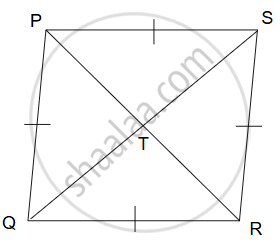Advertisements
Advertisements
प्रश्न
Complete the following activity to prove that the sum of squares of diagonals of a rhombus is equal to the sum of the squares of the sides.

Given:
`square` PQRS is a rhombus. Diagonals PR and SQ intersect each other at point Т.
To prove: PS2 + SR2 + QR2 + PQ2 = PR2 + QS2
Activity:
Diagonals of a rhombus bisect each other.
In ΔPQS, PT is the median, and in ΔQRS, RT is the median.
∴ By Apollonius theorem,
PQ2 + PS2 = `square` + 2QT2 ...(I)
QR2 + SR2 = `square` + 2QT2 ...(II)
Adding (I) and (II),
PQ2 + PS2 + QR2 + SR2 = 2(PT2 + `square`) + 4QT2
= 2(PT2 + `square`) + 4QT2 ...(RT = PT)
= 4PT2 + 4QT2
= (`square`)2 + (2QT)2
∴ PQ2 + PS2 + QR2 + SR2 = PR2 + `square`
उत्तर
Given:
`square` PQRS is a rhombus. Diagonals PR and SQ intersect each other at point Т.
To prove: PS2 + SR2 + QR2 + PQ2 = PR2 + QS2
Activity:
Diagonals of a rhombus bisect each other.
In ΔPQS, PT is the median, and in ΔQRS, RT is the median.
∴ By Apollonius theorem,
PQ2 + PS2 = \[\boxed{2\text{PT}^2}\] + 2QT2 ...(I)
QR2 + SR2 = \[\boxed{2\text{RT}^2}\] + 2QT2 ...(II)
Adding (I) and (II),
PQ2 + PS2 + QR2 + SR2 = \[{2(\text{PT}^2 + \boxed{\text{RT}^2})}\] + 4QT2
= \[{2(\text{PT}^2 + \boxed{\text{PT}^2})}\] + 4QT2 ...(RT = PT)
= 4PT2 + 4QT2
= \[\boxed{(2\text{PT)}^2}\] + (2QT)2
∴ PQ2 + PS2 + QR2 + SR2 = PR2 + \[\boxed{\text{QS}^2}\]
